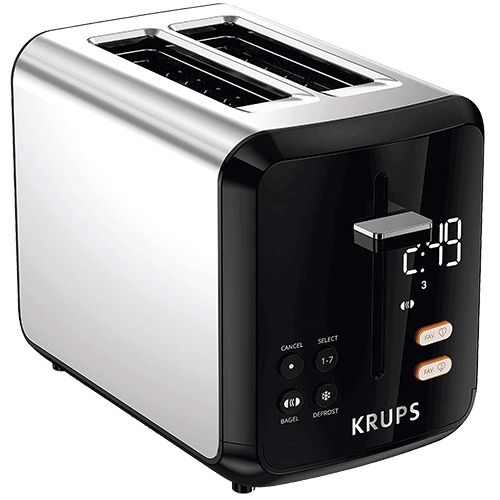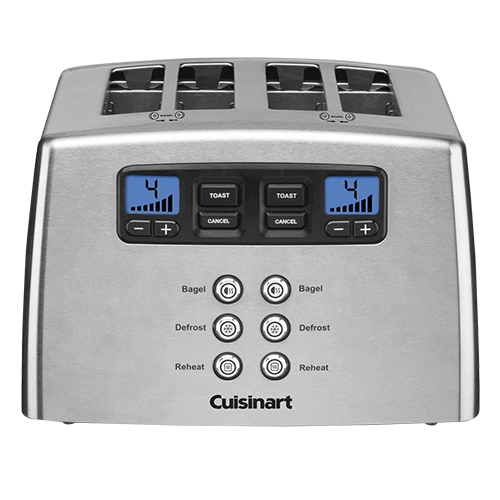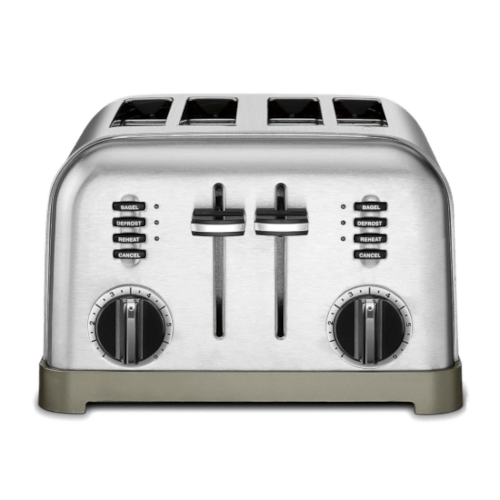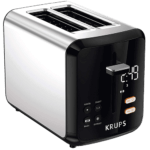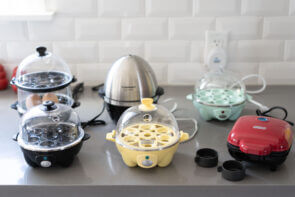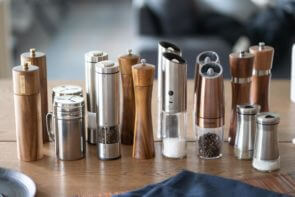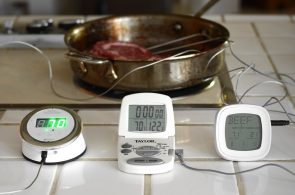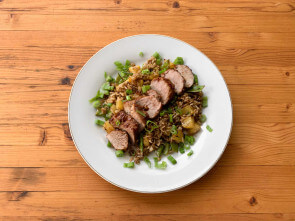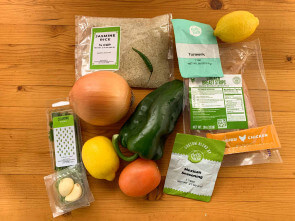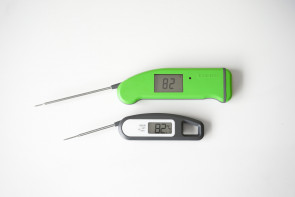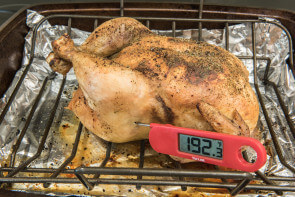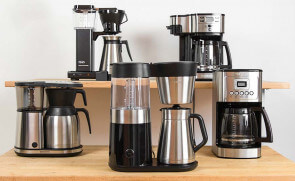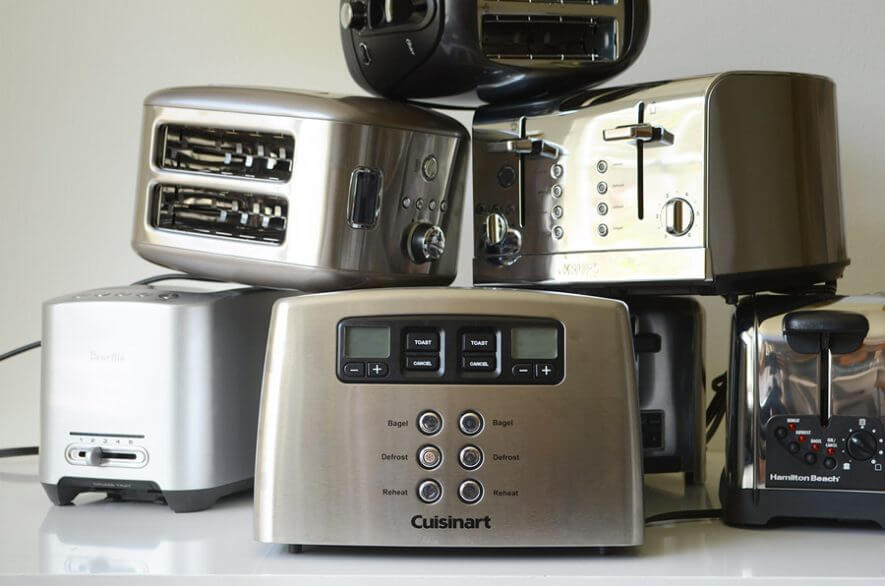
The Best 2 & 4 Slice Toasters
After years of testing toasters, we selected the KRUPS – KH320D50 as the best 2-slice toaster for consistently toasting bread, bagels, and breakfast pastries evenly. Another great 2-slice toaster is the Hamilton Beach – 22816, which is a little bit cheaper and almost as good. For the best 4-slice toaster, we recommend the Cuisinart – CPT-440, which is especially good for toasting multiple batches back-to-back. If you’re looking for more bang for your buck, the best value 4-slice toaster is the Cuisinart – CPT-180 Classic. And if you’re looking to upgrade your toaster to match your new kitchen appliances, go for the Breville – BTA830XL.
After years of testing toasters, we selected the KRUPS – KH320D50 as the best 2-slice toaster for consistently toasting bread, bagels, and breakfast pastries evenly. Another great 2-slice toaster is the Hamilton Beach – 22816, which is a little bit cheaper and almost as good. For the best 4-slice toaster, we recommend the Cuisinart – CPT-440, which is especially good for toasting multiple batches back-to-back. If you’re looking for more bang for your buck, the best value 4-slice toaster is the Cuisinart – CPT-180 Classic. And if you’re looking to upgrade your toaster to match your new kitchen appliances, go for the Breville – BTA830XL.
Table of contents
- The 17 toasters we tested
- 1. Best 2-slice: KRUPS – KH320D50
- 2. Also great 2-slice: Hamilton Beach – 22816
- 3. Best 4-slice : Cuisinart – CPT-440
- 4. Best value 4-slice: Cuisinart – CPT-180 Classic
- 5. Upgrade pick: Breville – BTA830XL
- Other finalists we tested
- How we selected
- How we tested
- What to look for in a toaster
- The bottom line
(Editor’s note: In early 2021 we learned that several toasters we previously reviewed had been discontinued: Hamilton Beach 22790 two-slice, Proctor Silex 24216 four-slice, Hamilton Beach 24990 four-slice, Bella Pro Series four-slice, and Black+Decker TR2900SSD. We tested four new toasters for this 2021 update. Reviews follow below.)
The 17 toasters we tested
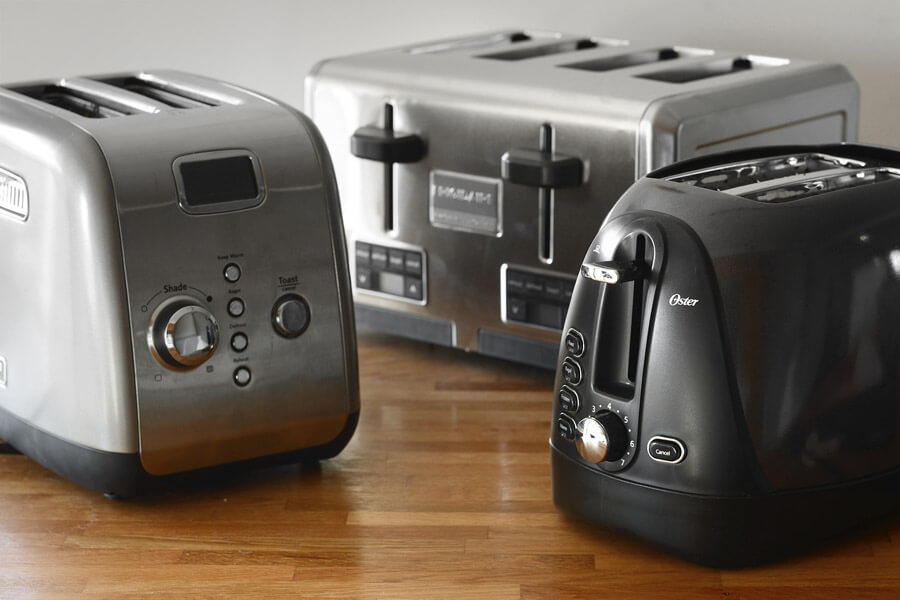
2-slice toasters
| Toaster | Price | Toast Evenness (1–3) | Consistency Across Batches (1–3) | Bagel Setting (1–3) |
|---|---|---|---|---|
| 1. KRUPS - KH320D50 | $$ | ☆☆☆ | ☆☆☆ | ☆☆☆ |
| 2. Hamilton Beach - 22816 | $ | ☆☆☆ | ☆☆☆ | ☆☆ |
| 3. Amazon Basics | $ | ☆☆ | ☆☆ | ☆ |
| 4. Cuisinart - CPT-620 | $$ | ☆ | ☆ | ☆ |
| 6. KitchenAid - KMT2116QG | $$$ | ☆☆ | ☆☆☆ | ☆ |
| 7. Oster - Jelly Bean | $ | ☆☆☆ | ☆☆☆ | ☆ |
| 8. Black+Decker - TR2900SSD | $ | ☆☆☆ | ☆☆ | ☆ |
| KitchenAid - KMT223 (Discontinued) | $$$ | ☆ | ☆ | ☆☆☆ |
| Hamilton Beach - 22790 (Discontinued) | $ | ☆☆☆ | ☆☆ | ☆☆☆ |
| Cuisinart - CPT-122 (Discontinued) | $ | ☆☆☆ | ☆☆☆ | ☆☆ |
4-slice toasters
| Toaster | Price | Toast Evenness (1–3) | Consistency Across Batches (1–3) | Bagel Setting (1–3) |
|---|---|---|---|---|
| 1. Cuisinart - CPT-440 | $$ | ☆☆☆ | ☆☆☆ | ☆☆ |
| 2. Cuisinart - CPT-180 Classic | $$ | ☆☆☆ | ☆☆☆ | ☆☆ |
| 3. Breville - BTA 830XL | $$$$ | ☆☆ | ☆☆ | ☆☆☆ |
| 4. Krups - KH734D | $$ | ☆ | ☆☆ | ☆☆☆ |
| 5. Hamilton Beach - 24990 | $$$ | ☆☆ | ☆☆ | ☆☆ |
| Proctor-Silex - 24216 (Discontinued) | $ | ☆ | ☆ | ☆☆☆ |
| Bella - Pro Series (Discontinued) | $$ | ☆☆ | ☆☆ | ☆ |
1. Best 2-slice: KRUPS – KH320D50
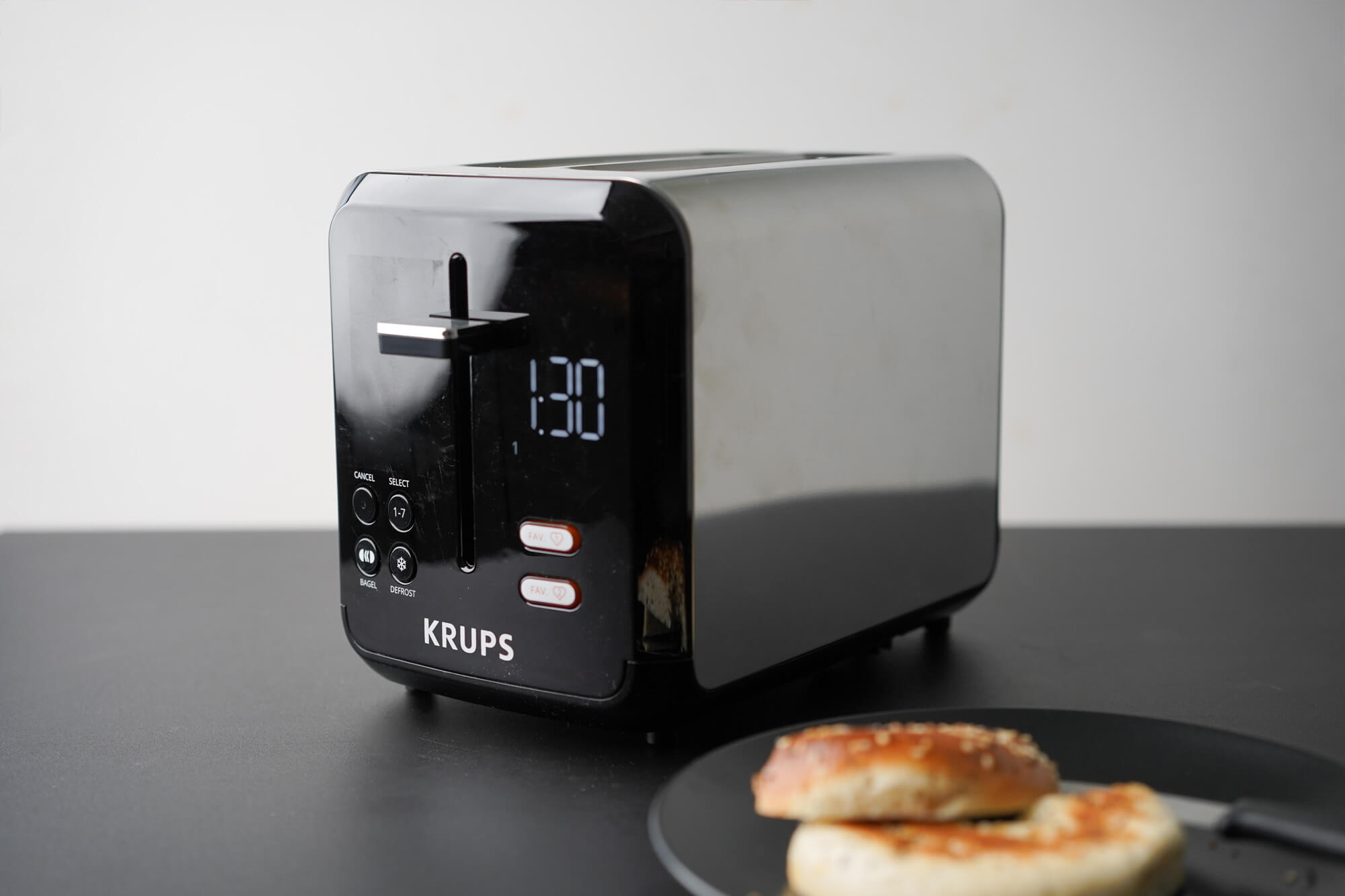
The KRUPS – KH320D50 is a moderately priced two-slice toaster that gave the most consistent results than the three other toasters that we tested for this update. Its sleek, modern appearance with stainless-steel trim includes a large, easy-to-read LED digital display that counts down the minutes and seconds as the bread toasts, which is a nice feature when you’re trying to time everything else for breakfast or lunch.
Before we actually tested its toasting performance, as with all toasters, we had to run it through a couple of toast cycles at the highest level to burn off any residue from manufacturing and packaging. The KRUPS did have a strong chemical odor that completely dissipated after the second cycle. After that initial disappointment, it no longer mattered because the KRUPS’ performance in all of our tests was superb.
The KRUPS has seven pre-set cycles, and for all the toasters, we began testing at the mid-level, in the KRUPS’ case level four, which is set at two minutes, 30 seconds. The toast popped up golden brown on one side, and golden on the opposite side. Both exteriors were crunchy, and the interior was pleasingly soft.
We experimented with the presets — higher and lower — and each one toasted the bread evenly on both sides. Level 3 was perhaps the lightest we’d go for toast, however, since the toast was very lightly toasted. The lowest settings are for toaster pastries, which need warming rather than toasting.
Our favorite function was for bagels, which almost all modern toasters now have. For the KRUPS, the cut side is inserted facing the heating element, just like the other toasters we tested except for the Cuisinart – CPT620. Bagel connoisseurs demand a crunchy cut side and slightly chewy crust. We’re not bagel experts, but the KRUPS’ bagel met those requirements, though the crust was a little crunchy too. Nevertheless, it was delicious.
The KRUPS also has a memory feature, so when you like a certain setting, you can program it, so the toast will come out exactly as you want it every time. The KRUPS has a high pop-up, so you lift the lever and pluck the toast out without burning your fingers.
The KRUPS – KH320D50 is a bit more expensive than other two-slice toasters. But if you’re a toast fanatic and want every slice perfect, then the little extra will be worth it.
Key takeaways:
- The KRUPS – KH320D50 has seven presets for toast, bagels, and toaster pastry.
- Its bagel setting was the best of the new toasters we tested.
- The KRUPS was the most consistent, evenly toasting both sides from top to bottom.
- It’s a little more expensive than other 2-slice toasters.
2. Also great 2-slice: Hamilton Beach – 22816
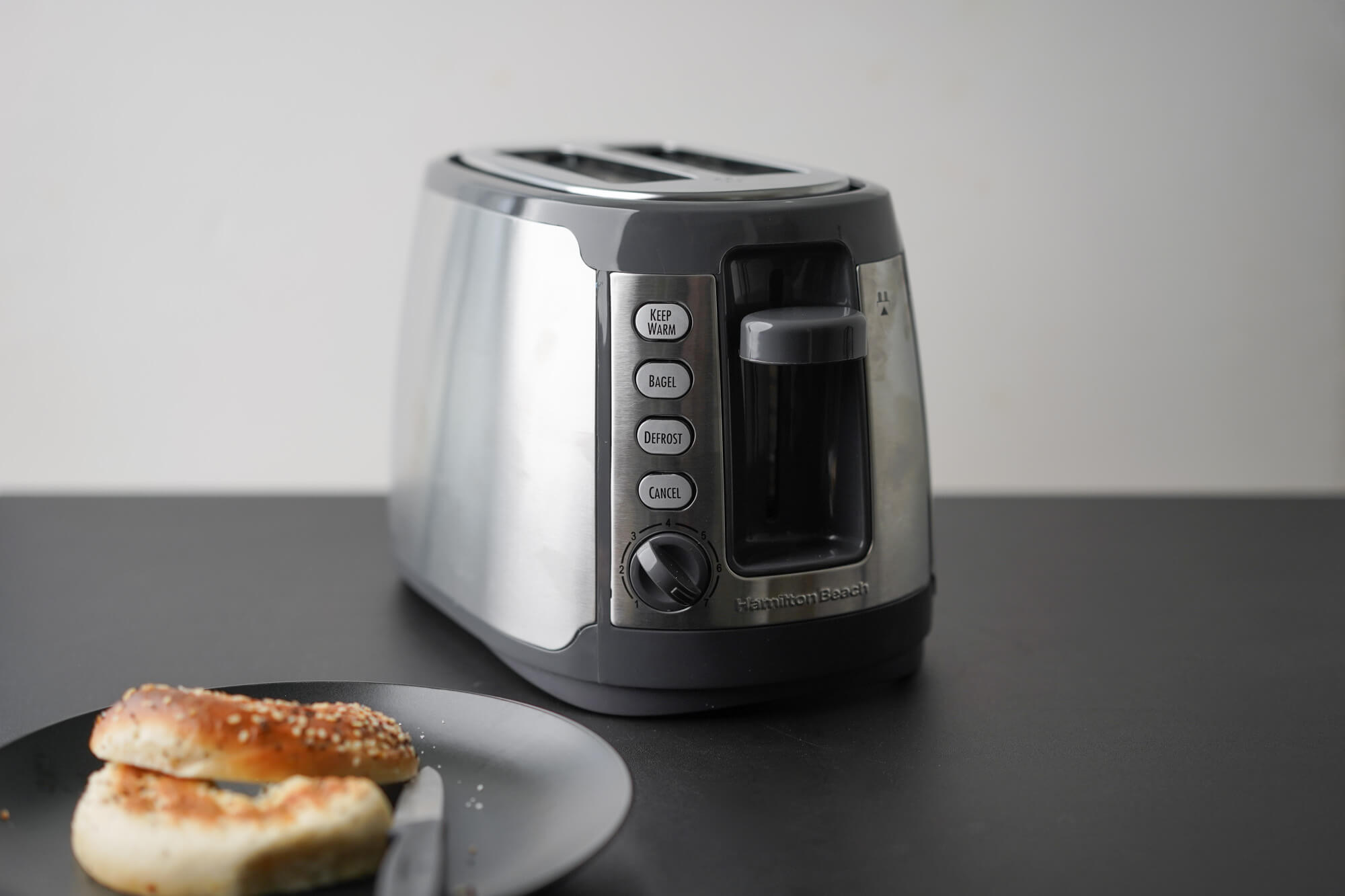
About one-third less expensive than the KRUPS is the Hamilton Beach – 22816, which performed nearly as well. It has the same features as the other toasters we tested, but the Hamilton Beach has an additional “keep warm” function. When activated, the toaster holds the toast in the slots for three minutes, so you can have warm toast at the same time you’re getting the eggs on the table.
Another feature we liked is that a few seconds before the toast is ready, the toaster emits an electronic beep, so you can grab the toast as soon as it pops up. The Hamilton Beach has a plastic body that’s accented with thin sheets of stainless steel, and its odd v-shaped design makes it stand out from the overly crowded market for toasters.
The Hamilton Beach has seven toasting settings controlled by a dial, which we had to fiddle with before achieving the golden-brown toast we wanted (level 5). Although one side was slightly browner than the other, we were still impressed that the bread was pretty evenly toasted.
As for the bagel test, it’s inserted cut side inward, and at level 5, the cut side was golden brown. The bagel’s crust, however, was barely toasted, more warmed, so we upped the level twice, and finally got a bagel that had a crispy crust with the requisite chew.
When you purchase a toaster, there’s always a learning curve, and you’ll probably have to experiment with a few pieces of bread — as we did — to get the toast you prefer. The Hamilton Beach – 22816 is one of the company’s more recent models, and because it’s such a good performer, it’s likely that this modestly priced model will not be discontinued for some time.
Key takeaways:
- The Hamilton Beach – 22816 has “keep warm” and “alert” features that other toasters don’t have.
- It evenly toasted bread and bagels to golden brown in our tests.
- Its dial for setting toasting levels can be a little tricky at first.
3. Best 4-slice: Cuisinart – CBT-440
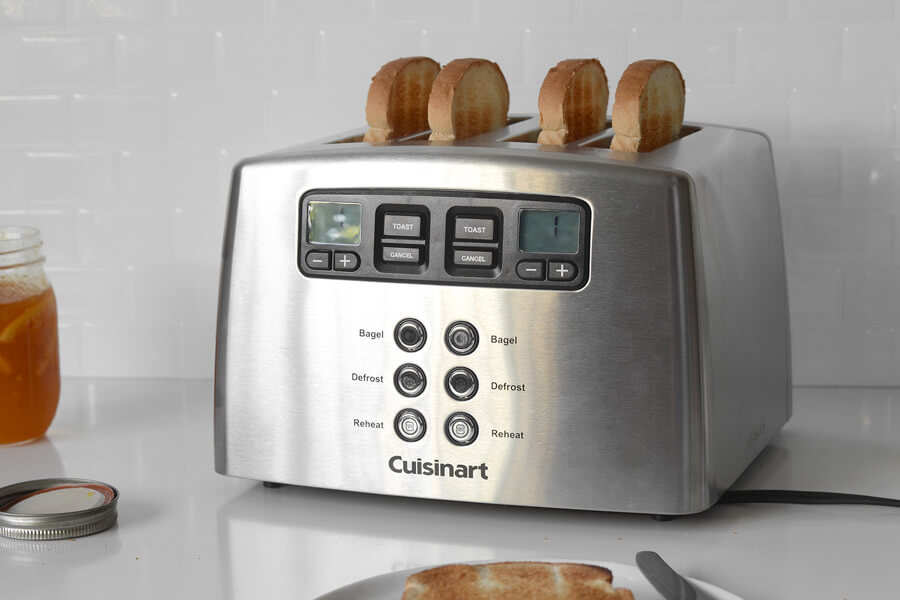
Across all of our testing, the Cuisinart – CPT-440 Touch to Toast performed extremely well. It is consistent, very fast, and evenly shades the entire surface of sliced bread. The four slots are wide enough to accommodate large, 1½-inch-wide food, the dual crumb trays catch a large majority of debris, and the stainless steel finish looks sharp. It’s a well-performing appliance and a great addition to any kitchen.
During our test for consistency, the Cuisinart continued to decrease the time bread spent lowered into the slots, ensuring that a medium toast looked the same after five rounds as it did after the first.
The toast was also well-colored from top to bottom and side to side, with just the slightest detectable difference front to back. The outside was hot and crispy while the inside maintained a moistness and chewy mouthfeel that was perfect.
At just two minutes and two seconds to complete the first round of medium toasting, the Cuisinart toaster is the fastest four-slot toaster and matched the fastest two slot, the Oster. Four slices of toast in just over two minutes put the Cuisinart toaster in a league of its own.
Because of the shorter toasting time, the Cuisinart does not accumulate the surface heat that other machines do. In fact, the Cuisinart is the only finalist we tested that stayed below a 90-degree surface temperature after multiple runs. It can safely and easily be moved around the kitchen immediately after use.
The one test the Cuisinart toaster failed to hit out of the park was frozen food. It required a second round of toasting to bring the interior temperature of the toaster strudel up to the desired heat. While that may not be ideal, it still got the job done in a timely manner.
The bagel setting functions as it should, and the bagels we enjoyed from the Cuisinart toaster were expertly crisped on the cut side and warm and soft on the outside. Just place the bagel in the slots as pictured on the machine and press the bagel button.
The extra-large slots can handle food items that are 1½ inches wide, so toasted sandwiches, frozen pretzels, or left-over pizza can easily be accommodated in a toaster bag. Keep in mind that you may want to lower the setting for extra-wide foods, as they do get close to the heated wires.
We also really like the design of the Cuisinart. The push-button automatic chamber feels futuristic and the heating mechanism slowly squeezes the food once it’s lowered to guarantee an even, complete toasting. The large LED screen is easy to view and the settings are intuitive.
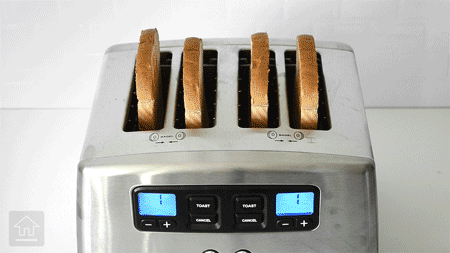
At just under $85 for high-quality components and craftsmanship that make great toast and can handle so many more common cooking tasks, the Cuisinart four-slot toaster is our pick for best overall.
Key takeaways:
- The Cuisinart – CPT-440 Touch to Toast Leverless consistently produces the same high quality every time it’s used.
- It creates evenly colored and crisped toast, with settings that are easy to adjust on an LED screen.
- Its four 1½ -inch-wide slots accommodate a variety of food.
- It toasted faster than any other four-slot toaster.
- The push-button mechanical lowering and automatic raising are luxurious and futuristic.
4. Best value 4-slice: Cuisinart – CPT-180 Classic
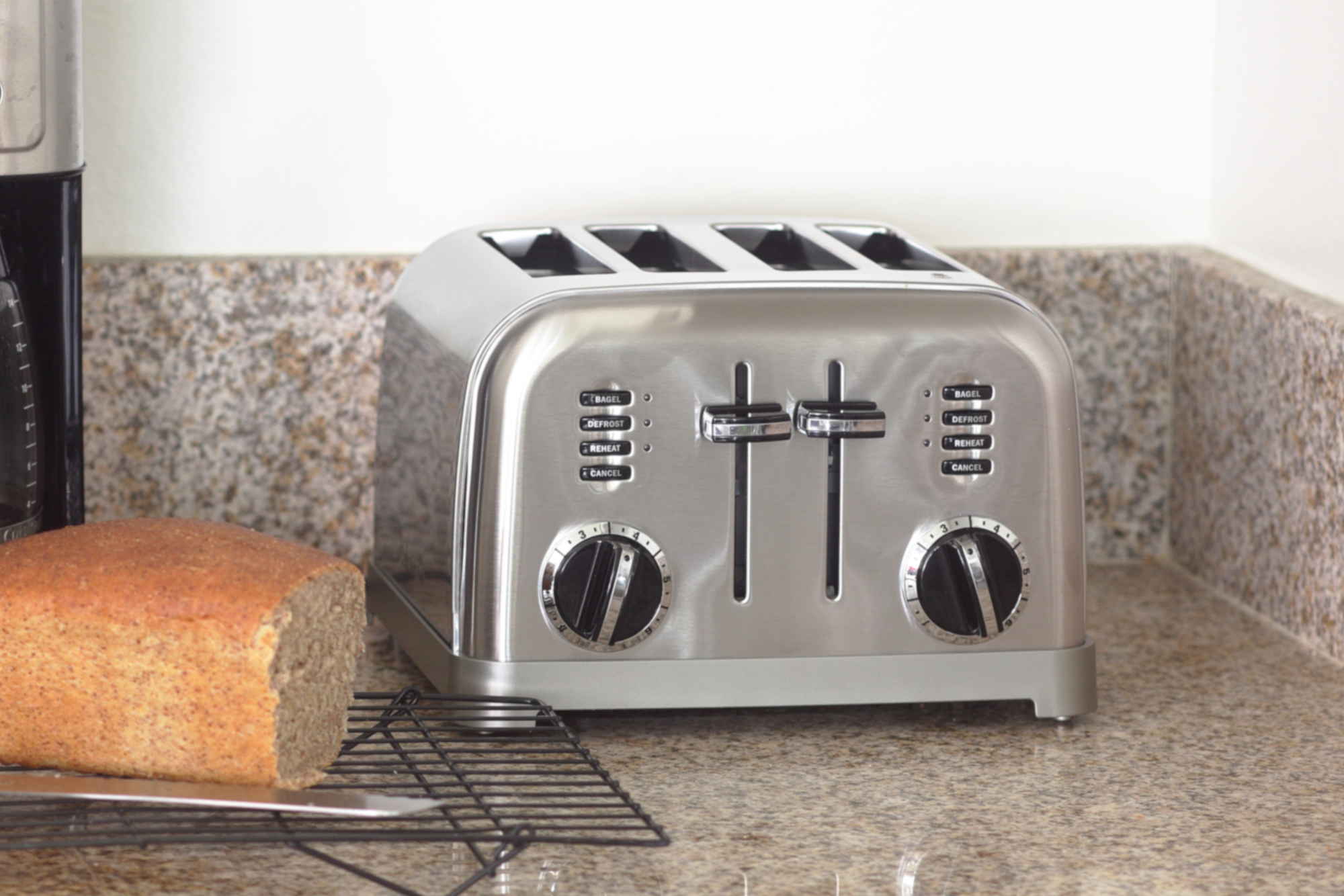
Cuisinart has a toaster to fit every budget. The Touch to Toast model above is still the best of the best unless you need to toast something that won’t fit in the slots, but we know some readers want a value-priced toaster instead. The Cuisinart – CPT-180 Classic gets you the impeccable toast quality of the 440, but at a much lower price. (It’s a bit easier to find, too.)
When you drop down from the Touch to Toast model to the Classic, you’re giving up the motorized levers, countdown timer, and a little bit of quality in the parts and finish. That said, the internal parts of Cusinart’s toasters all seem to be very similar, if not identical.
The one test where the stainless-sided Classic model pulls away from its siblings is in the defrost mode: For whatever reason, this was the only Cuisinart toaster we tested that kept heating until a frozen pastry was a piping-hot 157° on the inside. That’s not quite as hot as the Breville or Hamilton Beach results but nearly perfect for a quick snack.
There are a few things holding this toaster back from the very top spot, however. For one, the slots are slightly narrow, with the wire holders only accepting slices 1.2 inches wide compared to the full 1.5-inch capacity of the CPT-440. The rest of the build quality is a little bit lower than the CPT-180 440 as well, with knobs and buttons that feel more like a $40 toaster than a $60 toaster should. And if we want to be really picky, the toast from this and the other Cuisinart toasters was often a little darker on one side than the other.
When all the crumbs are swept away, the heating element and temperature controls are what count most, and this Cuisinart is as good as it gets.
Key takeaways:
- The Cuisinart – CPT-180, like the CPT-440, consistently pops out great toast.
- For defrosting toaster pastries, the CPT-180 was the best among Cuisinart models we tested.
- Narrower slots make this model slightly less versatile than the CPT-440.
- The Cuisinart – CPT-180 is not the cheapest toaster we tested, but the price for performance is excellent.
5. Upgrade pick: Breville – BTA-830XL
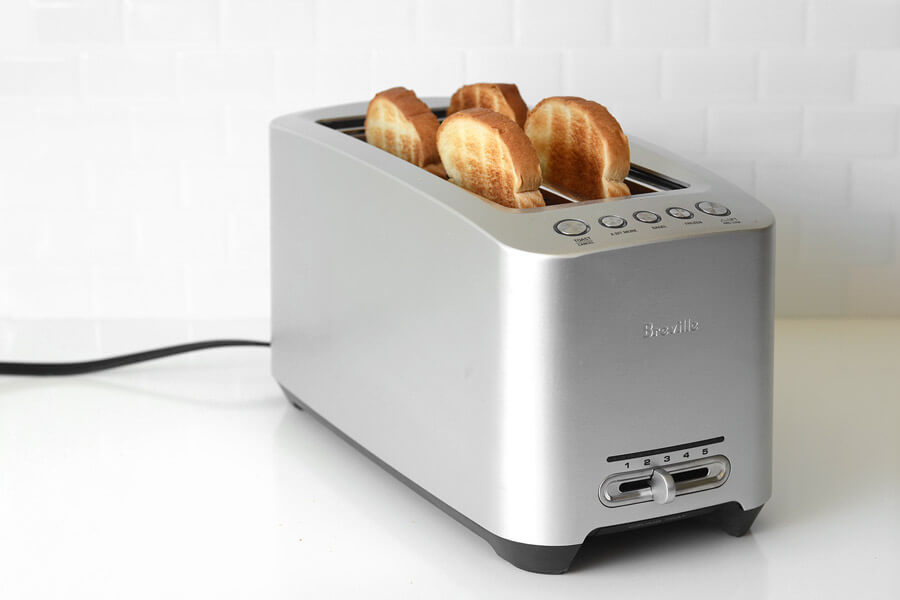
The Breville – BTA-830XL (about $180) is a two-slot toaster that’s unlike all others. It can fit four regular slices of bread, two bagels or two larger pieces of sourdough within its two 10-by-1.75-inch slots. This can come in handy when toasting irregular slices of bread, making paninis or reheating a slice of pizza with a toaster bag.
Its modern matte stainless-steel design features a motor that slowly lowers and automatically raises the slices when they’re toasted without the user manually pushing down a lever and eliminating the need for a sudden pop-up when the toast is done.
During the evenness tests, we found that the Breville’s toast was close to the same shade across the slice, but the crust was slightly darker than the middle. However, after toasting five consecutive slices, the toast increased in doneness and by the last slice, the edges were burned.
The toaster continued to accumulate heat as our testing progressed and it was hotter to the touch at the end of several rounds than most other toasters we tested. After one toasting, which lasted two minutes and 40 seconds, the outside temperature was 85°, and after the second one-minute and 55-second toasting, it was 91°.
During our frozen pastry test, the Breville performed very well and the Toaster Strudel was perfectly toasted after just one round on the frozen setting — even though the outer edges ended up a bit more toasted than the middle. The outside crust came in at 210° and the inside filling was 162°.
When it came to toasting bagels, we found that the bagel setting performed as it should; the outside was still soft but warmed up, and the sliced inside was browned and toasted. However, the inside of the bagel was a bit too dark on the medium setting. Those who don’t want their bagel too brown should take it down to a lower level.
The Breville can accommodate bread just a bit wider than normal and a slice much longer than any other toaster we tested. However, it did brown the edges of the bread more than the middle, which is a pretty common trait as breads increase in thickness.
The Lift & Look button allows the user to move the slices up and down slightly during the toasting process to observe the shade of the toast. As it toasts, its LED display shows a visual countdown of when the toast will be done. When it’s finished toasting, it slowly raises the slices and emits a soft beep, which is adjustable in volume.
After we finished the testing, it came time to clean the crumb tray. We found that it’s easy to remove but doesn’t cover a large amount of surface area under the toaster. Compared with other toasters, many more crumbs were caught on the floor of the toaster and less ended up in the crumb tray.
Key takeaways:
- The Breville – BTA-830XL is perfect for artisanal breads like sourdough.
- Two extra-long slots give this a wider, narrower footprint than other four-slice toasters.
- LED tracking light that displays the progress of the toast is a great touch on a minimalist design.
Other finalists we tested
(Editor’s note: As several toasters we previously tested are now discontinued, for this 2021 update, we tested two more 2-slice toasters: the the Amazon Basics – 2-Slice and the Cuisinart – CPT-620.)
Amazon Basics – 2-Slice Toaster
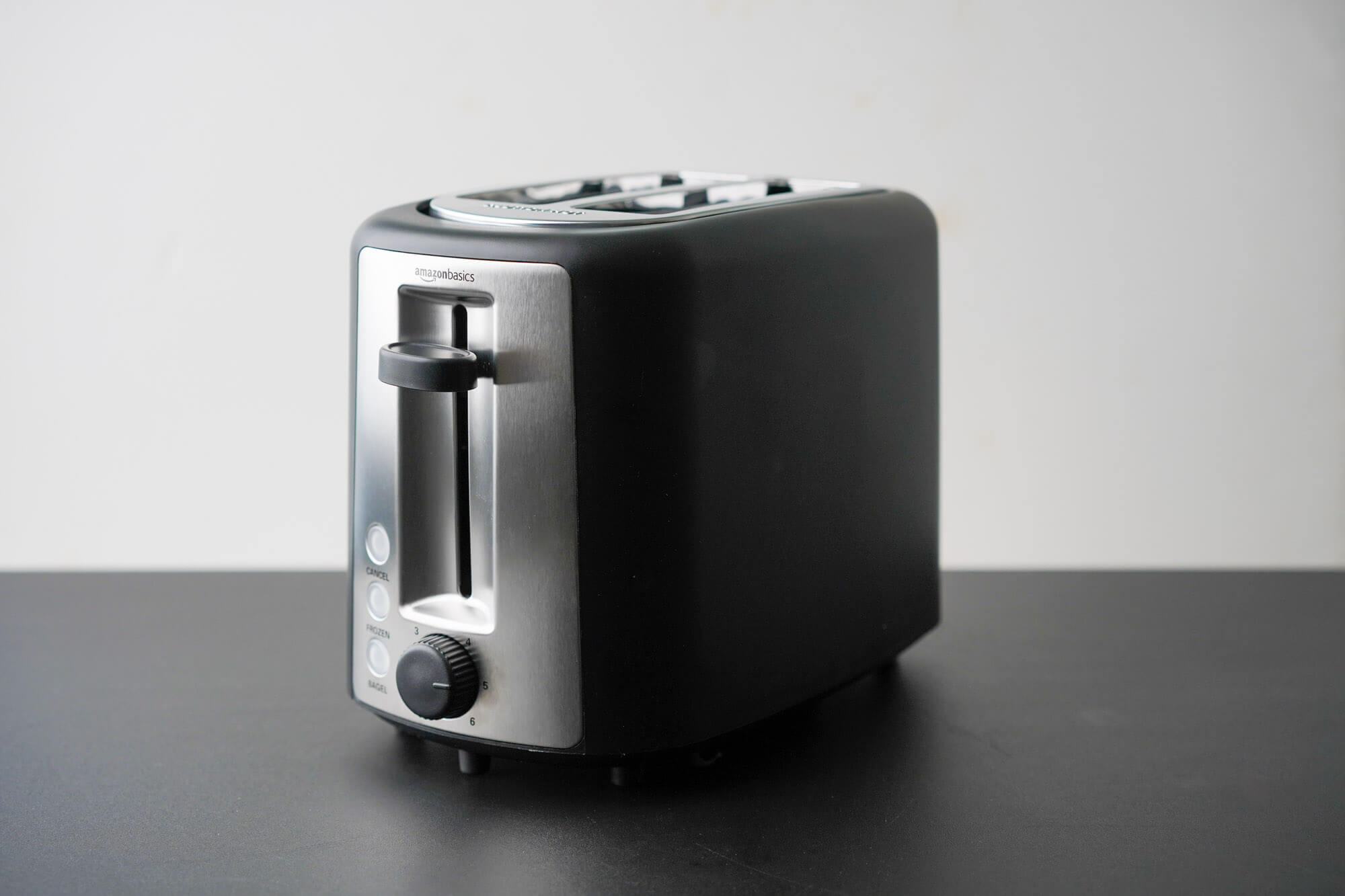
For a few bucks less than the Hamilton Beach – 22816, you could try the Amazon Basics 2-slice toaster. We were skeptical about Amazon getting into the toaster business, but it wasn’t a bad performer and is actually quite popular with consumers. However, after running the toaster through several cycles, the chemical odor from manufacturing persisted, even while toasting the first piece of bread in our tests, which was definitely not appetizing. It eventually did dissipate, but we did wonder why Amazon’s toaster took longer than the others.
That said, the Amazon Basics did what it’s supposed to do, but we had to increase the levels quite high before we got toast that was golden brown and not pale yellow. For some odd reason, the Amazon toaster is designed to not toast the bagel’s crust side; the outer coils shut down when the bagel function is selected. The cut side was toasted, albeit unevenly, but the crust was barely warm, which means you would have to double toast the bagel if you wanted a crunchy exterior.
Surprisingly, the Amazon Basics 2-slice toaster gave us almost identical results as the much more expensive Cuisinart – CPT-620. We recommend paying a couple of dollars extra for the better Hamilton Beach – 22816.
Cuisinart – CPT-620
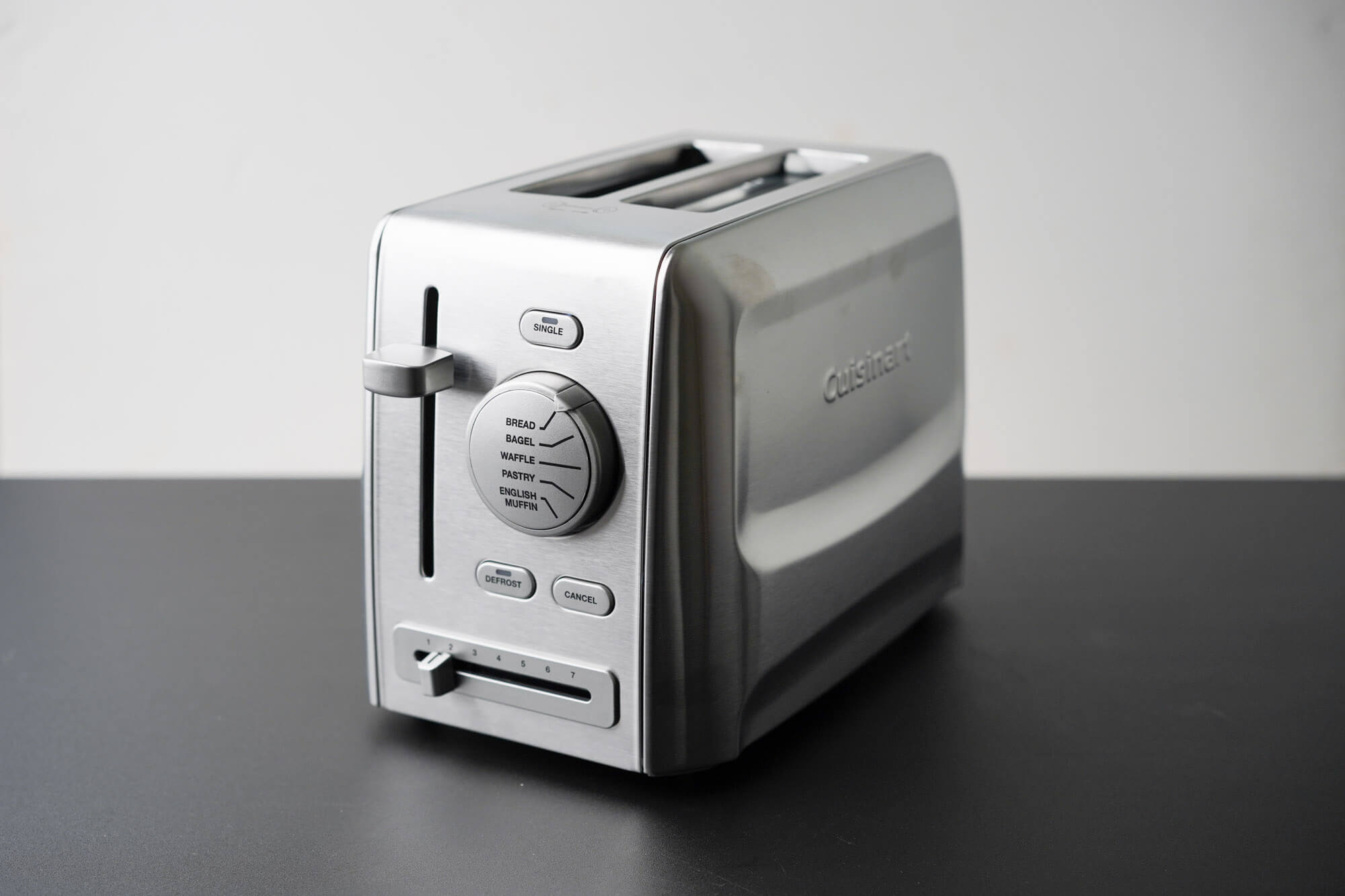
Without a doubt, the Cuisinart – CPT-620 is the glamour puss of the toasters we tested for this 2021 update. It’s a beauty, made entirely of stainless steel, with an elegant aesthetic that would belong in a high-end kitchen.
The Cuisinart is user-friendly thanks to its large dial for selecting the type of bread or pastry you want to toast, and it has seven levels for setting toast doneness. Consumer complaints often mention the lever for setting the level as inexact. We didn’t experience that problem; instead, we had to push the lever to the highest level just to achieve golden toast.
The Cuisinart’s bagel function produced less than desirable results: The cut side was very lightly toasted, and the crust side was soft and chewy with not a bit of crunch. It does have a unique “single slice” function for toasting one piece of bread or toaster pastry. But for all of the great design that was put into it, the Cuisinart – CPT-620 isn’t worth the money for such disappointing results.
KitchenAid – KMT2116QG
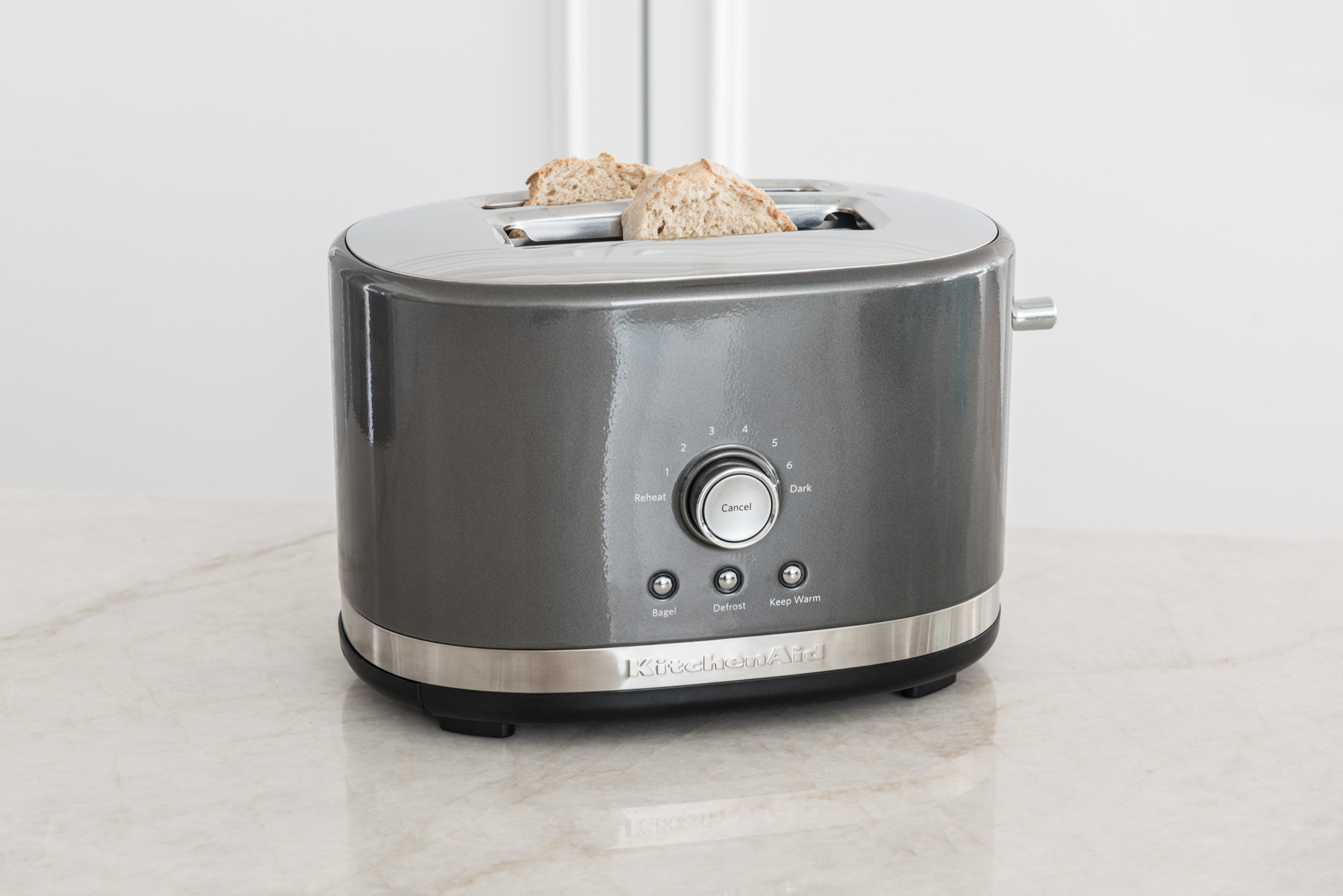
The KitchenAid – KMT2116QG is an attractive 2-slice toaster that melds modern technology with a retro look. It doesn’t have a wide range of functions, so it’s very easy to use. Like the Breville, this KitchenAid model has a handy “lift and see” lever that allows you to check on the toast’s shading without interrupting the toasting cycle. It also has a “keep warm” button that holds the toast at a low setting for three minutes.
Of the seven shade settings, the first three were too low and barely colored the bread or bagel. The fourth shade setting was more to our liking and toasted the bread an even golden-brown. We had less success toasting a bagel; at the fourth setting, only the top of the bagel toasted. We turned the bagel upside down and toasted it again, and this way we finally got an evenly toasted bagel.
As we experienced with other toasters, the defrost setting successfully toasted the frozen pastry crust, and although this setting was very hot, the pastry’s filling was cold. The model we tested was KitchenAid’s “liquid graphite” color and sells for $64 (the red and black toasters are about $15 more), which we think is too expensive for a toaster that doesn’t perform as well as the 2-slice Hamilton Beach.
Hamilton Beach – 24990
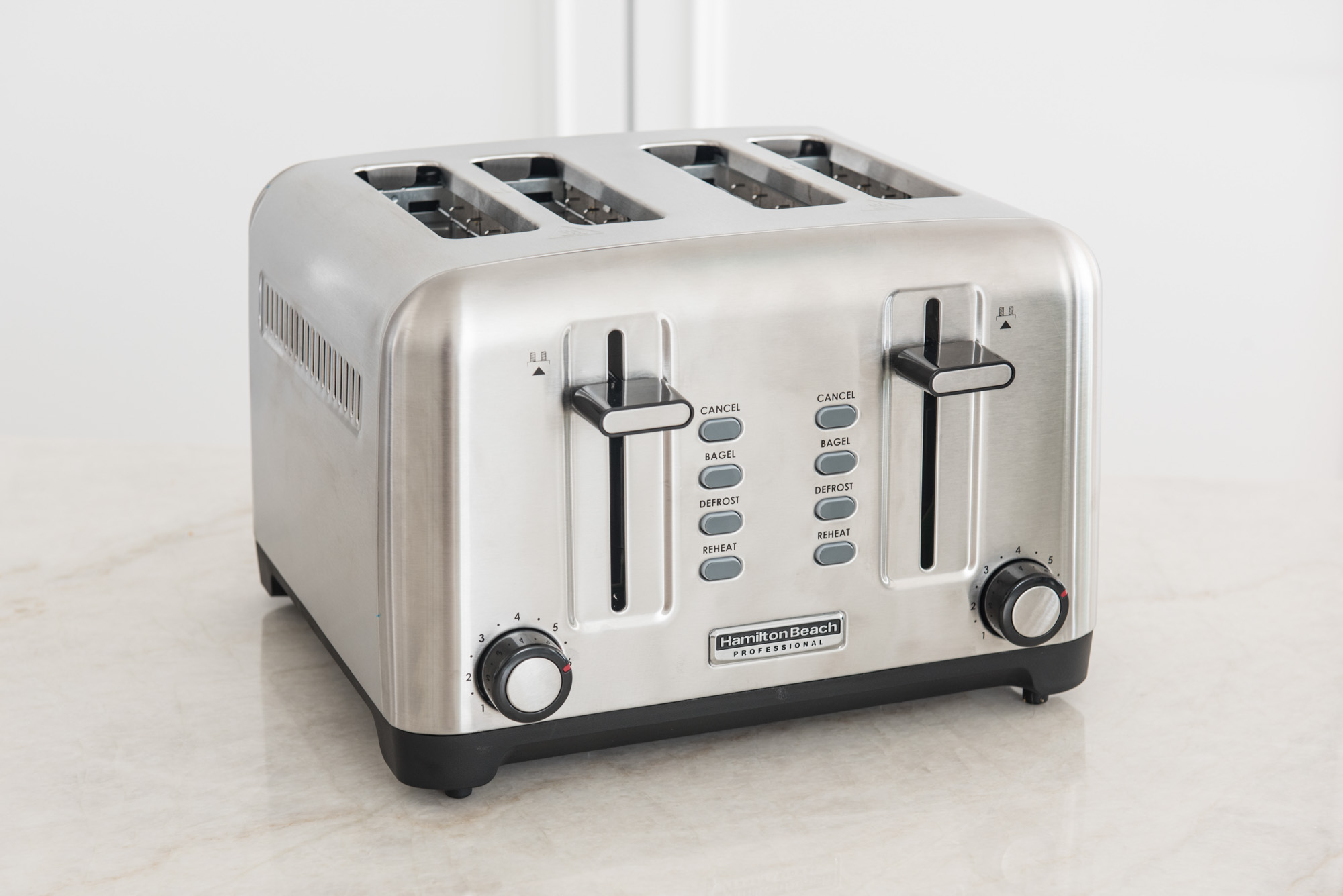
(Editor’s note: The Hamilton Beach – 24990 is no longer available on Amazon. However, Hamilton Beach is still selling this model on the company’s website.)
The Hamilton Beach – 24990 is s a four-slot toaster made of brushed stainless and would look great in any kitchen. Its four slots are wide and long to accommodate irregularly cut bread. Like other toasters we tested, it has buttons for bagel, defrost, reheat and cancel and two knobs with seven shade settings. Hamilton Beach markets this toaster as “professional,” which is boldly stamped on the toaster’s front. You might find this toaster in a small diner, but besides that, no restaurant would use it.
During our first use, an acrid smell rose up from the slots, which made our first toast test unappetizing. It eventually wore off by the third test. Repeatedly, in all of our tests, the bread and bagels were evenly shaded, but slices facing the right side of the toaster browned darker than the left-facing slices. Also, the outer slots popped up at least 10 seconds before the inner slots.
The top half of the slots seemed to be less hot than the bottom half, as evidenced by our bagel, which popped up two-toned. The Hamilton Beach defrosted the frozen pastry, and the filling was hot, but again, the right-facing side browned more. For $60, we expected more from this toaster.
KRUPS – KH734D 4-Slot
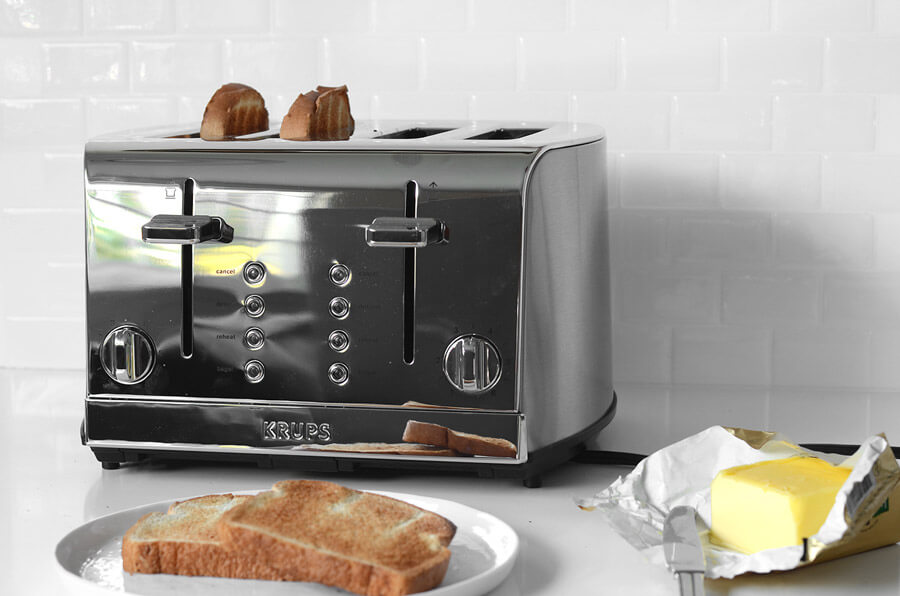
The Krups – KH734D is a four-slot toaster made of mirror-finished stainless steel and has a clean, modern look. Like the other four-slice toasters, it takes up a large amount of counter space, but its rounded edges give a sleeker, more circular appearance. For under $60, this is an impressively well-made toaster.
It proved itself as one of the most consistent toasters when we ran multiple batches. It reliably produced the same shading, texture and temperature across five slices of bread in our consistency test. However, it toasted one side of the bread more than the other and the bottoms of some slices didn’t toast as well as the rest of the slice. Overall, the Krups is also calibrated on the lighter side. Most users will find themselves only using settings four through six.
Bagels toasted perfectly with the Krups toaster. The inside was crunchy and a toasty golden brown and the outside was warm without getting too crisp. Just remember to set it fairly high if you want to see some actual browning.
On the whole, there are a few more issues holding the Krups back. When it’s done toasting the popping sound is fairly subtle. Then, even when it’s fully raised, smaller slices of bread and our breakfast pastry did not clear the edges of the slot, making pulling them out tricky, with lots of care needed.
As with our top pick, the Krups didn’t heat our frozen toaster pastry through on the defrost setting, and the filling was only 88°. In comparison, the Cusinart – Classic nailed it on the first cycle.
Oster – TSSTTRJBG1
The Oster – TSSTTRJBG1, also called the “Jelly Bean,” is a two-slot toaster that produces a medium toast that looks exactly the same every time. It also toast faster than any four-slot toaster, popping out medium toast in under two minutes in every round after the first.
While the Oster does have a bagel setting, it does not appear to operate any differently from the traditional toast setting. Our bagel came out crispy and a bit dry on both sides.
The Oster’s exterior also heats up much more than our other finalists. After just two cycles on medium, the sides of the machine were 120°, nearly 20 degrees hotter than any other toaster we tested and very hot to the touch.
Proctor Silex – 24216 (Discontinued)

The Proctor Silex – 24216 is a four-slot toaster with a plastic casing and very basic functions. It has six shade settings, but it toasts very lightly with the first three. We increased the shade setting and then tested the two end slots and the two middle slots separately: Both toasted the top half of the toast more than the bottom half.
The Proctor Silex doesn’t have a bagel function, but it actually toasted a bagel evenly with crispy bits on the cut side, and the non-cut side had the requisite chew that bagel lovers love. With the frozen pastry, it was trial and error. We toasted the pastry once, and since it needed more crisping, we flipped it over, lowered the setting and toasted it again. Finally, we got the results we wanted — flaky pastry and hot filling — but it took a lot of trouble to get them. The Proctor Silex is well-priced, but for a few dollars more, the Cuisinart – CBT-180 is a better toaster.
Bella – 90076 Pro Series 4-slice (Discontinued)
Bella had our attention after they cleaned up in our waffle iron review, so we tested the Best-Buy exclusive Bella – 90076 Pro Series 4-slice toaster on account of a second-best overall rank in Consumer Reports’s toaster reviews. It failed to win our hearts.
For about $10 less, the Cuisinart Classic had a more balanced range of toast settings, and the Bella didn’t differentiate enough on the bagel setting. Bella’s settings all ran a little longer than Cuisinart’s, and the toast was always darker on one edge.
Black+Decker – TR2900SSD 2-slice (Discontinued)
We searched far and wide for another reputable, easy-to-find budget toaster, and the Black+Decker – TR2900SSD at Target is a near-miss. This two-slice toaster with a brushed stainless-steel finish is fairly attractive, and they were least trying to be a little bit different with the cancel button in the middle of the control knob.
The Black+Decker delivered a good slice of toast, but the consistency across batches wasn’t as good as Cuisinart and the bagel setting was barely different from the toast setting. It also took 40 seconds longer to toast than the Cuisinart. At about $5 more than the Hamilton Beach, there’s really no reason to prefer this model.
Hamilton Beach – 22790 (Discontinued)
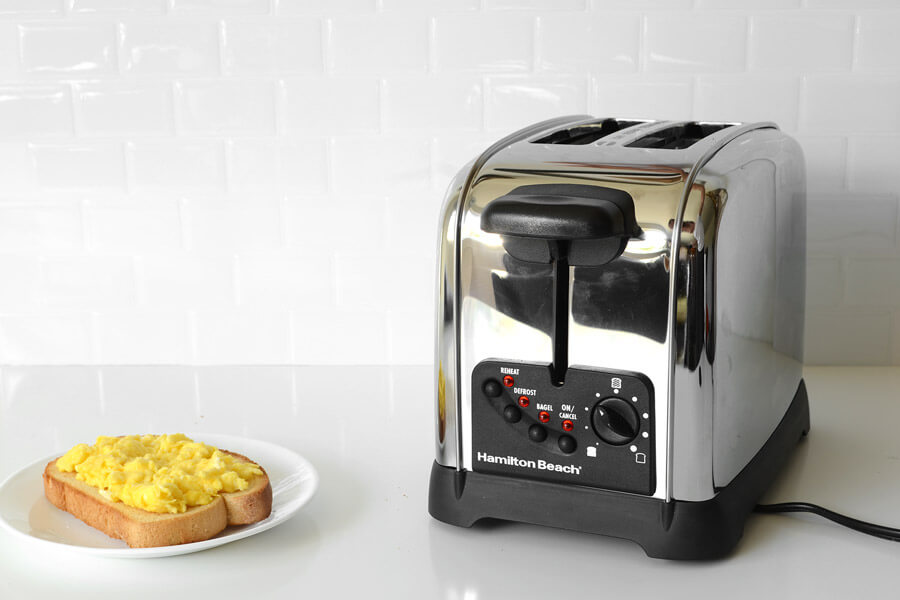
If a four-slot toaster gives away too much precious counter space and you’re in the market for something more compact, the Hamilton Beach – 22790 is the right choice. And at under $25, it offers the best value.
The Hamilton Beach toaster offers even shading over the entire surface of bread and the same on both sides. However, it does tend to toast darker in consecutive uses, so you may want to adjust the setting as you go, if you’re making lots of toast or bagels.
Both the defrost setting and the bagel setting operate extremely well. Our breakfast pastry was a hot 225°F on the outside and a warm 185° on the inside, perfect and ready to eat after just one round. Our bagel had the optimal temperature and texture on both the crust side and cut side.
The compact design of the Hamilton Beach toaster means slightly smaller slots, measuring just past 1¼ inch wide. While that may somewhat limit your options, it is a necessary trade for a smaller footprint and a high-quality product.
One thing that the Hamilton Beach does better than any other machine we tested is making it easy to remove your food. The lever can be raised beyond its neutral resting position to bring the food clear of the hot slots. This allows you to get your food out without having to resort to a utensil or worrying about burning your fingers.
KitchenAid – KMT223 2-slice (discontinued)
KitchenAid discontinued the sleek, high-end KMT223 two-slot toaster in 2019. During our initial testing, we observed that the KitchenAid toaster failed to modify the time and heat intensity in consecutive uses. Each slice of toast was darker and drier than the one before. There was also a clear difference between the bottom and top of the bread itself: The bottom half toasted darker than the top half. The KitchenAid performed very well on both the bagel and the frozen food tests, however.
Cuisinart – CPT-122 (discontinued)
(Editor’s note: Since our review, Cuisinart has discontinued this model, although it is still available at many online retailers.)
Cuisinart’s line is carefully segmented by price and feature set: each retailer has a slightly different model, though most of them produce very similar toast.
The major practical difference between this toaster and the CPT-160 or CPT-180 “Classic” models is the insulating nature of the plastic sides: The hottest spot we could find on the sides of the plastic toaster was 97° after toasting most of a loaf of bread, compared to 130-degree hotspots on other toasters. Safety concerns really aren’t much different, though: Most toasters won’t burn you if you brush your hand against the side, and this plastic model still has metal slots that concentrate the 900 watts of heat up top.
The plastic Cuisinart, like the top-of-the-line digital model, requires multiple runs of “defrost” to actually get the inside of a frozen pastry hot. The Cuisinart – CPT-180 and Hamilton Beach – 24990 toasters fared better in that test.
Frigidaire – Professional 4-slice (discontinued)
We tested this digital-control toaster in our original roundup to see how it stacked up against the other premium models. We liked the reflective stainless steel finish and the digital LED countdown timer, but toast quality was disappointing. Frigidaire has discontinued this model and hasn’t replaced it.
How we selected
We began our quest to find the best toaster by compiling reviews and research from popular sources on home goods like Consumer Reports, Good Housekeeping, CNET, and Bon Appetit magazine.
We also read cooking blogs and talked to other consumers to discover how often people use a toaster, what functions are most useful, what the most common complaints are, and what makes a great toaster.
The predominant characteristics that people look for in a good toaster are:
- Reliability: Does a given setting produce an expected result time after time?
- Consistency: Is the food item toasted evenly over the entire surface?
- Versatility: Can the toaster accommodate a wide variety of foods?
- Aesthetics: How visually attractive is the appliance?
- Footprint: How much counter space is used?
- Features: Do special features work accurately and intuitively?
- Cleaning: How easily can the appliance be cleared of crumbs and debris?
- Affordability: Do better results necessarily require spending more money?
How we tested
Speed and consistency
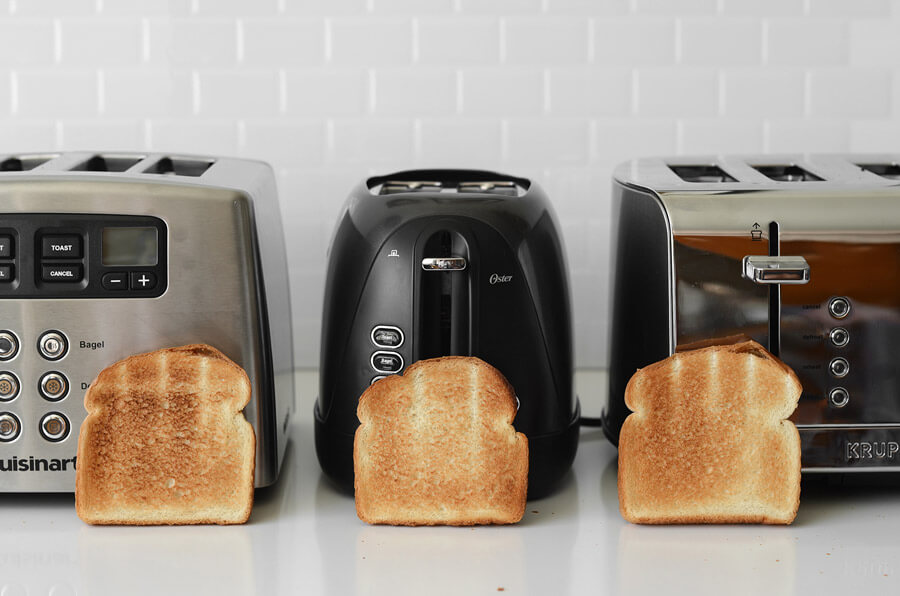
We wanted to find out how reliably each toaster produced the same shading and texture on the same medium setting over five toasting cycles. Everyone likes toast a certain way, but can the toaster predictably create that certain way for you every time?
For this test, we used slices of Wonder Bread and set each finalist to its middle setting. We also wanted to see any difference between slots, so we cycled through the slots over the five consecutive toasting cycles.
All of the finalists we tested decrease the amount of time per cycle progressively as the machine gets hotter. The average time to reach a medium toast the first time around was two minutes, 47 seconds. That dropped to an average of two minutes, 15 seconds on the second round, with further incremental drops each round.
The toasters that created the most consistent results adjusted the time that the toast spent in the slots while also altering the intensity of the heat. The toaster with the smallest variance in time between rounds, the Oster -TSSTTRJBG1, also produced some of the most similarly toasted slices round after round. Other toasters that offered close to uniform consistency were the Cuisinart and the Hamilton Beach.
Not only were the Cuisinart and Oster toasters reliable, but they were also the two fastest, both with first-round times of two minutes and two seconds. At just under four minutes, the now-discontinued Frigidaire – Professional was by far the slowest to achieve a medium toast.
Toast quality
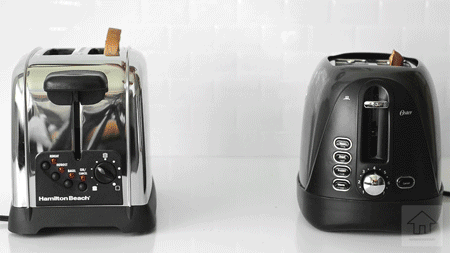
After observing the speed and consistency of multiple rounds, we turned our attention to the quality of the toast itself. We wanted to see bread that had been evenly colored from left to right, top to bottom, and on both sides. The ideal toast would be crispy on the outside without being too dry or flaky all the way through — a bit of a crunch with a warm and light interior.
Many of the toasters provide an evenly shaded slice from left to right on the same side, but there is a discernible difference between the top and bottom, with the bottom almost always being a bit darker. There was also often a large variation from one side of the bread to the other.
Only the toast made with the Hamilton Beach – 22790 was the same on both sides of the bread. All of the others produced toast with a lighter side and a darker side. With some, the difference was very slight, like the KitchenAid and Cuisinart, but many were noticeably darker on one side, as with the KRUPS toaster.
Making a taste comparison between the models is difficult, as everyone has different taste buds, different expectations and different reactions. However, the toast that the Frigidaire toaster made had a clearly different texture than all the others. It seemed denser and compressed: The edges crumbled and flaked with even the most careful handling.
Settings
Bagels
All of the toasters on our list of finalists include a bagel setting. Most also have a decal near the slots that illustrates what direction to face the sliced side of the bagel. The goal is to toast a bagel with a golden brown, crispy cut side and a warmed but still chewy opposite side. We used fresh bagels that we cut in half right before toasting, and we also double-checked the mode with a slice of bread to see how big the difference between sides really was.
The bagel setting works by increasing the heat on just one side of the slot. Clearly, this technology has been well-developed, as we were pleased with most all of the bagels that popped up. The one disappointment was the Oster, which seemed to do the exact same thing to both sides of the bagel. The medium bagel setting was also much darker than we would have expected.
Krups earned some points here with a bagel setting that crisped the inside while only just warming the outside of the bagel.
Frozen
In order to test the ability of the direct-from-the-freezer setting, we set each toaster to either frozen or defrost and lowered a Pillsbury Toaster Strudel into the slot. The goal was a crispy, flakey exterior and a warm — but not too hot — gooey filling inside. In addition to our texture and taste observations, we used an infrared thermometer to measure the temperature of both the outside surface and the inside filling of the pastry after one, and if necessary, two rounds of toasting.
Both the Cuisinart and the Krups needed two rounds on frozen set to medium to cook a finished product that was ready to eat. After just one cycle, the pastry was just barely warm to the touch, with a cool, less-than-delicious center. The other models all succeeded in making a toaster strudel with an interior temperature above 160°F after the first cycle.
Slot size
While all the toasters we tested are marketed as having large, wide slots, we wanted to see how the machines actually handled larger slices of bread. We cut several loaves of french bread into ½-inch, 1-inch, and 1½-inch-wide segments and ran them through our finalists. For reference, a slice of Wonder Bread is about half an inch.
As the slices get wider, they get closer to the heated wires inside the slots and the edges darken quicker and more dramatically than the middle surface area of the bread. If you typically enjoy a traditional sliced toast at any given setting, you may want to decrease the setting for thicker slices since it will toast quicker.
For some of our finalists, 1-inch-thick bread came out a bit uneven in terms of shading and quality. Several toasters, including the Hamilton Beach and the Oster could not accommodate the 1½-inch cut pieces; their slots were simply too narrow. The others performed with varying degrees of success, with the clear winner in this category being the Breville.
Surface heat
Obviously, the inside of the toaster will be hot, but the outside should remain relatively cool to be handled easily after use. Again, we used our infrared thermometer to take the temperature of the outside surface of the toaster after one and two rounds on the medium setting.
Most of our finalists hung around the mid-80s and low-90s (F°) for surface temperature, which is warm but not dangerously hot. However, the Oster shot up above 100° after just one round and to 122° after the second. At this temperature, the toaster was very hot to the touch and couldn’t be moved without oven mitts for several minutes.
Other features
Finally, we tried to take into account all the other aspects of the user experience that are hard to quantify but are still important. We looked at how easily the crumb trays are removed and cleaned and how efficiently they trap crumbs inside the machine. We spent hours assessing how intuitive and easy each toaster is to use.
We observed LED screens, timers, lever lifts that raise the toast higher out of the slots and push buttons that automatically lower and raise the food. We compared dings, beeps and the feeling you get from using and simply looking at the toaster in the kitchen to help determine the best of the best.
Why you need a pop-up toaster
Some may think that there are many ways to heat bread, bagels, and frozen waffles. An oven that can handle a Thanksgiving turkey can surely accommodate a couple of slices of bread and a pan over the stove can also toast bagels. So, why even bother with a slot toaster?
Slot toasters are the best and easiest way to make toast and a lot of other foods quickly and consistently.
Making toast in the oven — or even in one of the winners from our review of the best toaster ovens — makes inferior, dried-out toast. Because of an oven’s size, the heat source is far from the bread and with the volume of air inside, food dries as it cooks, which is why marinate and baste chicken and turkey.
In a slot toaster, the heat source of heat is close and the duration of toasting is quick, so the moisture inside your bagels and bread doesn’t escape. This creates the crispy outside you want but leaves a warm, soft and chewy inside.
You can also make toast on a stovetop or even a portable induction cooktop, and it’s certainly quicker than waiting for the oven to preheat, but the pan has to be actively tended and then washed. The ability to simply push a button or lever and then move on to other tasks makes a slot toaster much more convenient — particularly for those mornings when minutes seem to fly by as you try to get out the door.
Beyond toast
Clearly, the toaster is an ideal tool for making toast, frozen breakfast treats and bagels. But the vertical slots of a toaster make it less versatile than a toaster oven when you’re heating or cooking other food. That is, it was, until someone invented a clever hack.
Toaster bags, made of heat-resistant and food-safe silicone or Teflon, allow you to cook pretty much anything that will fit in the slots. The bags, which trap any crumbs, melting cheese, or loose topping are washable and reusable. This is now the quickest, cleanest and easiest way to reheat last night’s pizza or create gourmet sandwiches.
With the confined shape of toaster bags, you can also add your favorite toppings or spreads before toasting. Grilled cheese or even peanut butter sandwiches come out hot and ready without any extra dishes. During our testing, we even made toaster panini with chicken, pesto and goat cheese.
You can also make hot sandwiches in a waffle maker, but as we found out in our review of the best waffle makers, even a non-stick waffle iron takes much more work to clean up than a toaster bag.
What to look for in a toaster
Number of slots
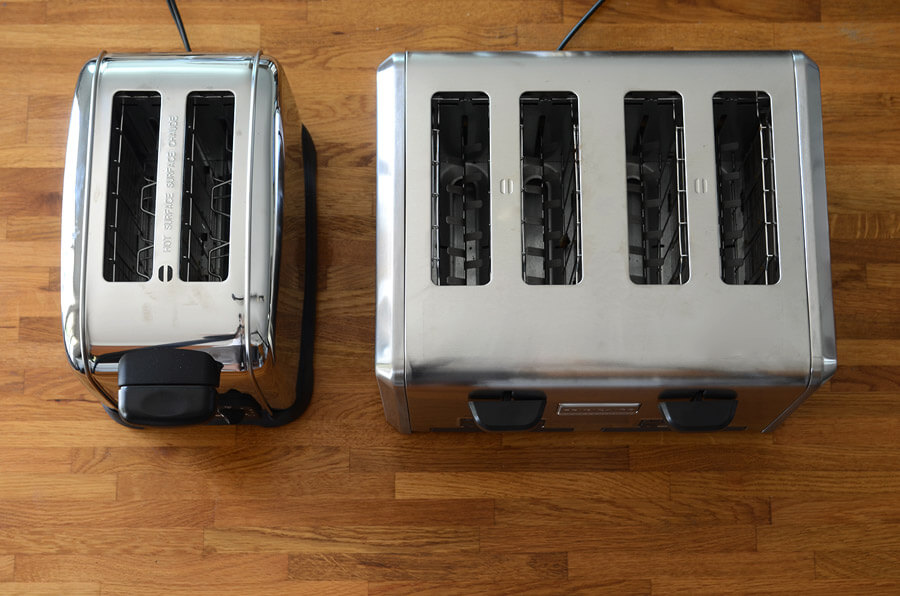
A single person or couple will most likely be served well with a two-slot toaster while a larger family would probably benefit from the extra slots, particularly when multiple people need to use it in a short time period.
The size of your kitchen and your aesthetic taste will also dictate how much of your counter space you want to dedicate to a toaster. For a 300-square-foot studio with a small kitchen, a two-slot toaster is probably going to be the right decision.
Crumb tray
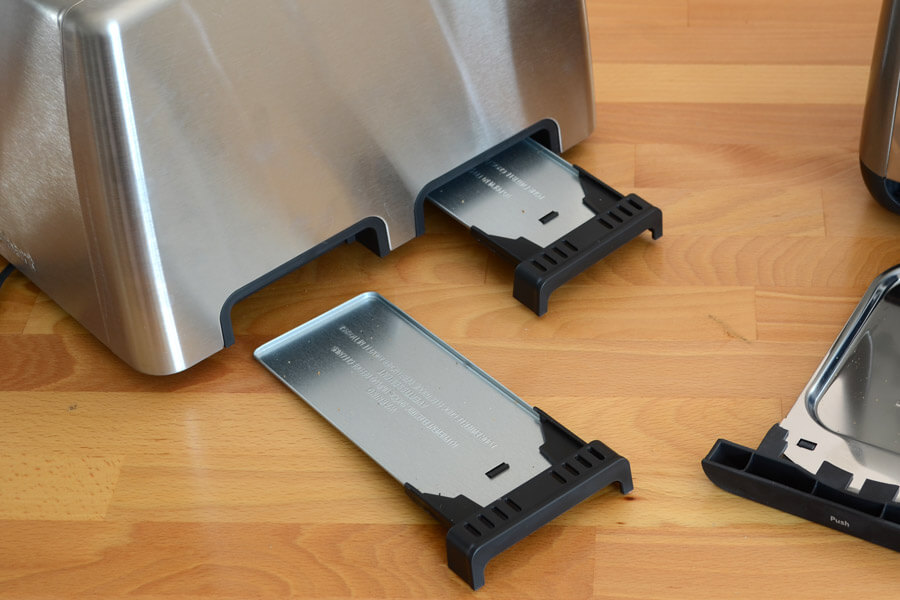
The crumb tray — a small, thin, metallic sheet that slides out from the bottom of the toaster — is a crucial feature. The tray catches all of the inevitable crumbs and debris that flake off bread during the toasting process. All of our finalists have crumb trays and we strongly advise against buying a toaster without one.
Slot size
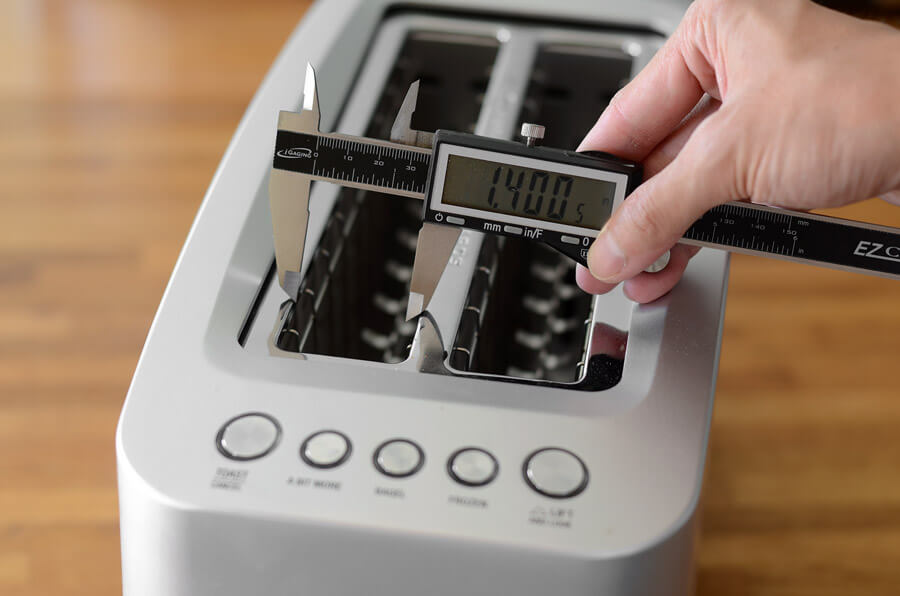
The length and width of the slots will determine what can actually fit inside and smaller slots limit your ability to toast larger and more varied food items. The emerging standard width is 1½ inches, which is featured in all except one of our finalists. The lengths hover between 5 and 6 inches, with the exception of the Breville – BTA830XL, which sports two unique 10-inch long slots.
Features
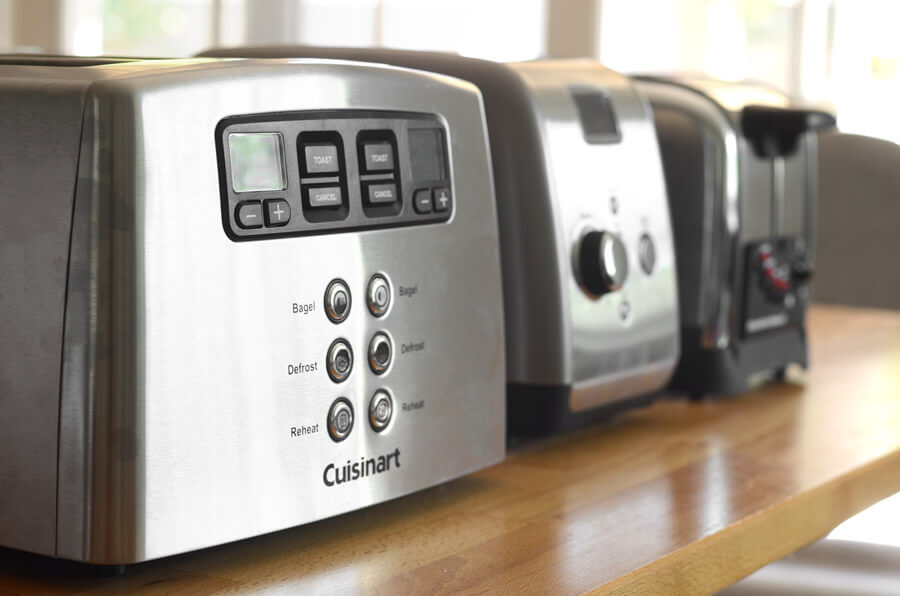
Beyond simple toasting, there are several other pre-programmed features with which some toasters are equipped that change exactly how the toaster heats a given food item. For example, the most common feature is the bagel setting, which makes a darker, crispier inside and prevents over-cooking the crust of a bagel by changing the intensity of the different heated coils. While all of our finalists have a bagel function, they are not all created equal.
Another popular setting is the frozen or defrost button, which is designed for food coming directly from the freezer. Again, all of our finalists have this feature, but it performs differently from model to model.
Some frozen settings simply increase the time of a given cycle while others actually lower the intensity of the heat or more gradually increase it to prevent burning the outside before the inside is done.
Other popular features to consider are levers, push buttons, LED displays, sound alerts, countdown timers, a cancel function and the ability to lift the food high enough out of the slots to make removing it by hand easy and safe.
Price
More expensive toasters almost always look sharper and sleeker, but they don’t necessarily make drastically better toast. Cheaper options may take a bit longer and produce less even coloring and texture than pricier models, which often have more wattage and more heated wires.
It’s likely that a more expensive model that’s made with higher quality, more durable components will last longer. Some offer warranties while others don’t. In the end, your budget and personal preferences will help determine which one of our top picks will be your favorite.
The bottom line
Slot toasters are incredibly efficient and provide the perfect texture and toast shade quicker, easier, and more reliably than other methods. With the use of reusable toaster bags, a good toaster becomes a versatile and almost essential appliance for any kitchen.
Our pick for the best 2-slice toaster is the KRUPS – KH320D50, a sleek, moderately priced toaster with great features that give consistent results.
If you’re looking for something a little less expensive, we also recommend the Hamilton Beach – 22816, another 2-slice toaster that alerts you when your toast is done and then keeps it warm until you’re ready for it.
The best 4-slice toaster is the Cuisinart – CPT-440 Touch to Toast Leverless because of its consistency, usability and value. The four slots are wide enough to handle almost any food; the pre-programmed settings for bagels and frozen food work exceptionally well, and it looks and feels sharp and modern.
If those premium digital control features aren’t what you’re looking for, the performance from the more conventional Cuisinart – CPT-180 is our value pick 4-slice toaster
For a bit more versatility, our upgrade pick, the Breville – BTA830XL, offers unique 10-inch-long slots that are perfect for artisanal breads or reheating pizza.
More Reviews
The 8 Best Electric Egg Cookers
Elite Gourmet - EGC-007B
The 8 Best Salt and Pepper Grinders
Merazi Living
Blue Apron
Martha & Marley Spoon
HelloFresh Meal Delivery Kit Review
HelloFresh
LEM Products - 1152
OXO - Barista Brain


